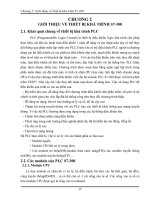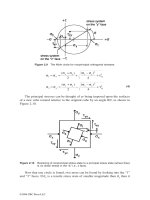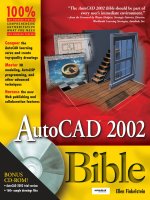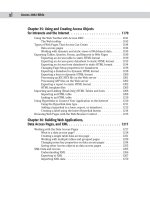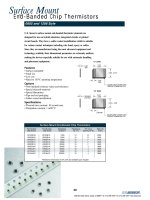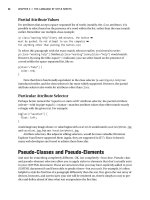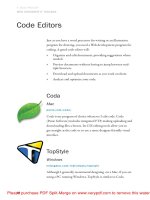Tài liệu AutoCad 2002 Bible P2 doc
Bạn đang xem bản rút gọn của tài liệu. Xem và tải ngay bản đầy đủ của tài liệu tại đây (207.27 KB, 10 trang )
4
Part I ✦ AutoCAD Basics
Through a high level of technical innovation and expertise, Autodesk has created a
program with unequaled features and capabilities, including 3D surface and solid
modeling and visualization, access to external databases, intelligent dimensioning,
importing and exporting of other file formats, Internet support, and much more.
Autodesk has developed what it calls a virtual corporation. This “corporation”
includes programmers who create software designed to work with AutoCAD (called
third-party software), dealers (also called resellers) who provide technical support
and training specific to a user’s field, and an education network that provides train-
ing and courses to more than one million users each year. This setup provides a
strong network of support to users throughout the world.
The major disciplines that use AutoCAD are:
✦ Architectural (also called AEC for architectural, engineering, and construction)
✦ Mechanical
✦ GIS (Geographic Information Systems)
✦ Facilities management
✦ Electrical/electronic
✦ Multimedia
However, AutoCAD has many other lesser-known uses, such as pattern making in
the garment industry, sign making, and so on.
In this book, I try to provide examples from many fields. The world of AutoCAD is
very broad, and it is worthwhile to see the many approaches that AutoCAD makes
possible.
Starting AutoCAD
This section starts the quick tour of AutoCAD, designed to make AutoCAD look easy
and simple. The first step is to start AutoCAD.
The CD-ROM contains a 15-day trial version of AutoCAD 2002. Look in
\Software\AutoCAD 2002 Trial\Setup.EXE.
This book covers AutoCAD 2002 running on Windows 98, Windows ME, Windows
2000, or Windows NT 4.0. Every computer is set up somewhat differently, so you
may need to adjust the following steps slightly. If you didn’t install AutoCAD your-
self and are unfamiliar with the folders (once called directories) on your computer,
you should get help from someone who is familiar with your computer system.
On the
CD-ROM
033611-7 ch01.F 9/11/01 9:50 AM Page 4
5
Chapter 1 ✦ Starting to Draw
If you need help installing AutoCAD, turn to Appendix A.
By default, installing AutoCAD places a shortcut on your desktop, as shown in
Figure 1-1. You can double-click this shortcut to launch AutoCAD. Of course, you
can also choose Start ➪ Programs ➪ AutoCAD 2002. If a submenu opens, choose
AutoCAD 2002 again.
Figure 1-1: An AutoCAD shortcut on the desktop
provides a quick way to open AutoCAD.
Creating a New Drawing
When you launch AutoCAD, AutoCAD Today, shown in Figure 1-2, appears as
a cover page on top of your AutoCAD drawing window. AutoCAD Today
enables you to easily take advantage of your Internet and intranet connec-
tions from within AutoCAD.
Working with AutoCAD Today
AutoCAD Today has three sections:
✦ The top-left area (My Drawings) enables you to create new drawings or open
existing drawings. You can also access symbol libraries (sets of small draw-
ings that you can insert into your active drawing).
✦ The top-right area, called the Bulletin Board, displays a Web page from the
Internet or an intranet. This section is designed to be used by an AutoCAD
Manager to communicate with AutoCAD users.
✦ The bottom area is a window into Point A, Autodesk’s Internet portal.
These three areas are described in the next few sections of this chapter and in
Chapter 2.
To get right to work on your drawing, you can close AutoCAD Today by click-
ing its Close button (the X at the top right of the window). You can always
reopen it by clicking the new Today button on the Standard toolbar. AutoCAD
Today opens in a smaller window than AutoCAD itself so you can also simply click
anywhere visible on the AutoCAD screen to hide AutoCAD Today. You can then dis-
play AutoCAD Today at any time by clicking its button on the Windows task bar.
If you don’t like AutoCAD Today, you can make it go away. Choose Tools ➪ Options
and click the System tab. In the General Options section, click the Startup drop-
down list and choose either “Show traditional startup dialog” or “Do not show a
startup dialog.” The Startup dialog box offers similar options to AutoCAD Today.
Tip
New
Feature
Cross-
Reference
033611-7 ch01.F 9/11/01 9:50 AM Page 5
6
Part I ✦ AutoCAD Basics
Figure 1-2: AutoCAD Today connects you with your manager, Autodesk’s
Point A site, and makes it easy to create or open a drawing.
You can collapse either the top or bottom section of AutoCAD Today by clicking the
plus sign at the left of the section you want to collapse. Then click the minus sign to
redisplay its section. You can also expand or contract the Bulletin Board by clicking
its plus or minus sign.
For more information on how managers can configure AutoCAD Today, see
Appendix A.
Using AutoCAD Today to create a new drawing
At the top left of AutoCAD Today is the My Drawings section, where you can create
a new drawing or open any existing drawing. You can also access symbol libraries
(collections of blocks that you can add to your drawings).
To create a new drawing, click the Create Drawings tab of the My Drawings section
of AutoCAD Today. From the Select how to begin drop-down list, choose one of
three options:
✦ Template enables you to open a drawing using a template. Templates contain
settings that control how your drawing functions. The first group is Recent
Templates (if you have previously used a template). After that, templates are
grouped alphabetically. Click the arrow next to a letter to display the tem-
plates that start with that letter. You can also click Browse to open the Select
File dialog box and choose a template from the Template subfolder of your
AutoCAD 2002 folder.
Cross-
Reference
033611-7 ch01.F 9/11/01 9:50 AM Page 6
7
Chapter 1 ✦ Starting to Draw
✦ Start from Scratch enables you to choose English or Metric and create a
drawing with just the minimum default settings.
✦ Wizards enables you to choose either Quick or Advanced Setup to guide you
through the process of setting up a drawing before you start.
You can also create a new drawing from within AutoCAD. Choose File ➪ New or
click the New button on the Standard toolbar. AutoCAD displays AutoCAD
Today (unless you have changed the settings in the Tools dialog box as described
earlier) with the Create Drawings tab on top.
Step-by-Step: Starting AutoCAD and Creating a Drawing
1. Click Start on the task bar at the bottom of your screen.
2. Choose Programs.
3. Choose AutoCAD 2002.
4. If a submenu opens, choose AutoCAD 2002 again.
AutoCAD opens and displays AutoCAD Today.
5. Click the Create Drawings tab in the My Drawings section. From the Select
how to begin drop-down list, choose Start from Scratch.
6. Choose English (feet and inches). AutoCAD creates a blank drawing ready for
you to start drawing.
7. Click anywhere in the AutoCAD window that shows behind AutoCAD Today
(but outside AutoCAD Today) to see the blank drawing.
8. Click the Close button (the X at the very top right of your screen) to close
AutoCAD.
Exiting from AutoCAD is covered later in this chapter.
Using the AutoCAD Interface
You are probably impatient to start drawing. First, though, it helps to get the lay of
the land.
Figure 1-3 shows the screen when you first open AutoCAD. Your screen may look
somewhat different — remember that AutoCAD can be customized in many ways —
but the general features will be the same.
The AutoCAD screen consists of four important areas. These are discussed in the
next sections.
033611-7 ch01.F 9/11/01 9:50 AM Page 7
8
Part I ✦ AutoCAD Basics
Figure 1-3: The AutoCAD screen
The drawing area
The blank area in the middle of the screen, the graphics window, is where you draw.
You can think of this as a sheet of drafting paper, except that this piece of paper can
be any size — even the size of a huge factory!
At the bottom of the drawing area is a tab labeled Model. You draw on this tab. You
use the layout tabs to lay out your drawing for plotting.
To specify a point, the universally accepted convention is to put the X coordinate
first, then a comma, and then the Y coordinate. Figure 1-4 shows some coordinates
on X and Y axes.
Title bar
Menu bar
Command line Status barLayout tabs
Drawing minimize button
Drawing close button
Drawing maximize button
Standard toolbar
Object Properties toolbar
Application minimize button
Application maximize button
Application close button
Draw toolbar
Modify toolbar
Drawing area
User Coordinate System
(UCS) icon
Crosshairs
Pickbox
033611-7 ch01.F 9/11/01 9:50 AM Page 8

